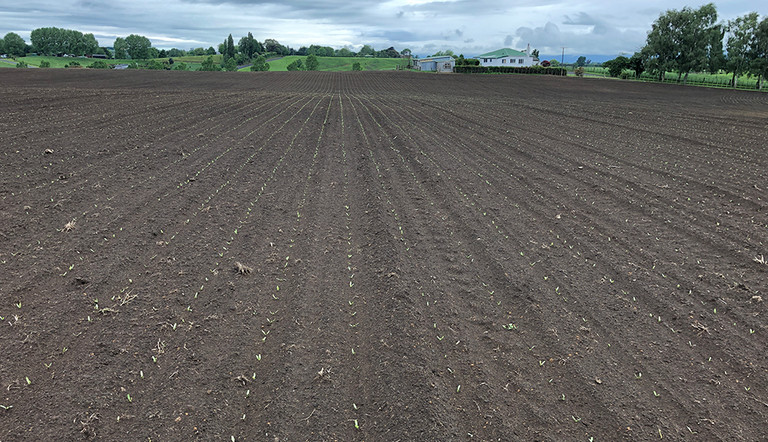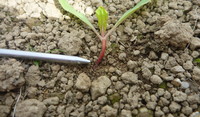
Science, expertise wrap around beet production

The science, specialist capabilities and expert advice being wrapped around beet crops are combining to produce significant results and dairy herd management benefits. That’s according to ADAMA New Zealand Commercial Manager Doug Speers.
ADAMA has invested in developing a suite of beet products spearheaded by Goltix® Gold herbicide. The two most recent additions to the toolbox are Mavrik® Aquaflow Insecticide (Mavrik) and Custodia® foliar fungicide, launched this season and last season respectively.
Doug says the breadth of the chemistry’s support is a direct result of the company listening to technical field officers and the needs of farmers.
Reaping rewards with careful husbandry, expertise and chemistry
“Some of New Zealand’s leading farmers are growing beet crops and their careful husbandry, combined with the expertise and products that are available means they have been reaping the rewards.”
He says an example is Matamata dairy farmers Bruce and Jacquie Tiddy who used the ADAMA programme including SP insecticide Mavrik, foliar fungicide Custodia and Goltix Gold herbicide.
The Tiddys grew 22 ha of sugar beet this season with yields pushing 30 tonnes of DM/ha and 15.2 ME. Their experienced technical specialist described it as “pure rocket fuel”. He said the Tiddy’s had benefitted from keeping the paddock clean of weeds and their meticulous approach to management.
Multi-faceted beet approach
Further growing expertise was provided by experienced contractor Paddy from Paddy Contracting Ltd based in Bulls who planted and lifted the Tiddy’s crop. Paddy explained that achieving an even germination was another factor critical to a successful crop. He says that in terms of value “it’s one of the cheapest crops you can grow.” The Tiddys are planning to plant sugar beet again in the coming season but are yet to decide on the hectarage.
ADAMA’s approach to beet is multi-faceted and very much in-line with current farming drivers. Doug says the beet programme makes a contribution to animal health and welfare by providing flexibility for dairy farmers grazing or lifting beets and addressing the increasing demand for chemistry that controls pests while protecting the wider environment. “It’s something we have worked hard to achieve.”
Mavrik - a break-through SP
ADAMA’s break-through synthetic pyrethroid (SP), Mavrik is proven in local trials to combine effective control of the serious fodder beet seedling pests Nysius and cutworm while being safer for beneficial insects.
Beets will generally hold their own once they reach canopy closure, but as experienced growers, agronomists and technical specialists will tell you, getting there is the real challenge. It is at this early post-emergence stage when beet seedlings are particularly at risk from Nysius and cutworm.
Vulnerable seedlings especially susceptible to Nysius
Nysius are found where vegetation is sparse and sunlight falls directly onto the ground, making vulnerable seedlings especially susceptible. Unchecked, Nysius feeding damage to the base of the plants can destroy a high percentage of the crop. The pest thrives under the hot, dry conditions many regions have experienced over the last two growing seasons.
Doug says application of Mavrik is recommended when Nysius are active as temperatures rise during the day; applying at seedling stage only, as a first post-emergence spray. “Apply at first sign of pest presence and ensure good coverage of plants and surrounding soil. A repeat application can be made after 14 days if required.”
Trials showed Mavrik provided a high degree of Nysius control and reduction of plant damage following one or two applications.
Larger cutworm caterpillars most damaging to beet seedlings
Trials also showed Mavrik prevented significant cutworm plant damage. After hatching, young cutworm caterpillars forage on leaves until they are about one third grown. Larger cutworm caterpillars lie curled up 25-50 mm below the soil surface during the day and emerge at night to feed. Larger cutworm caterpillars are also the most damaging, cutting seedlings off at their base.
Applications of Mavrik can control small cutworm caterpillars, preventing them growing to a much more damaging size. For larger cutworm, its recommended that spray applications should be made in the evening or night when the caterpillars emerge to feed.
Minimal impacts on key beneficials
Importantly, Doug says, Mavrik has minimal impacts on the key beneficials which help provide ongoing control of pests in the field.
“Tau-fluvalinate, the low toxicity active in Mavrik is proven to be much safer for beneficial insects, including parasitoids, predators, and pollinators, than other SPs available in New Zealand. Additionally, it is entirely crop safe when applied with approved ADAMA products at the sensitive cotyledon stage.”
Mavrik’s chemistry is consistent with recognising the vital role beneficials, including hoverflies and lacewings, can play in the health of the beet crop and other nearby crops. Hoverfly larvae feed on aphids of all kinds while the adult is an important pollinator. Lacewings are broad spectrum predators, effective against pests including aphids and other soft bodied insects, such as small caterpillars. “Effectively, they’re the farmers’ and growers’ free workers”, Doug says.
Comprehensive tool box
Another significant ADAMA product, Goltix Gold beet herbicide has a unique formulation, providing improved efficacy in controlling hard-to-kill weeds which can be the scourge of beet including fathen and wireweed.
Last season, ADAMA also introduced Custodia. This beet foliar fungicide supports greener, healthier, more vigorous leaves and has a withholding period 14 days less than other available fungicides – a lifetime when stock is hungry, and feed is tight.
Other compatible products in the ADAMA beet herbicide programme include ToreroTM, Ethosat®, and Rifle®.
